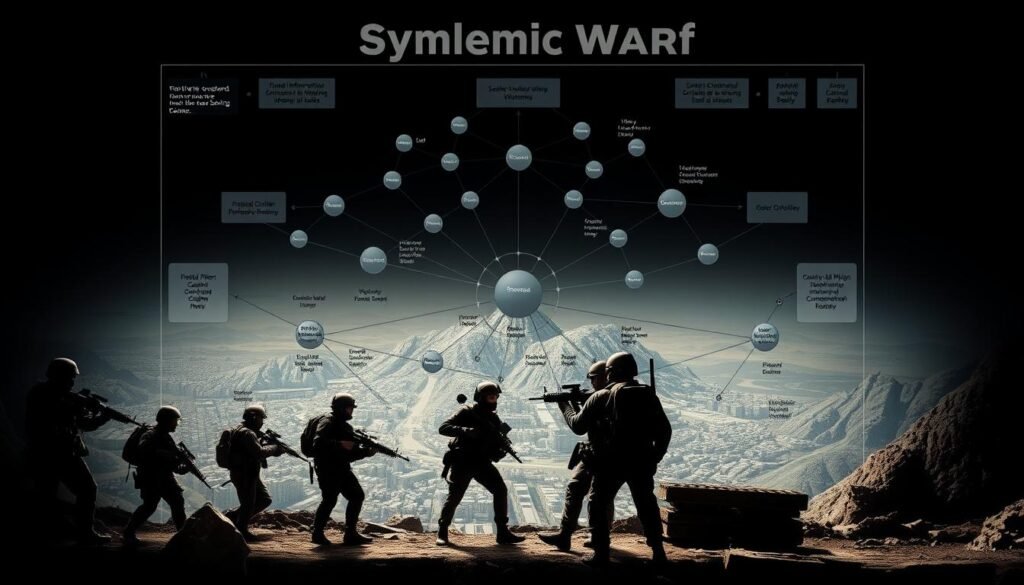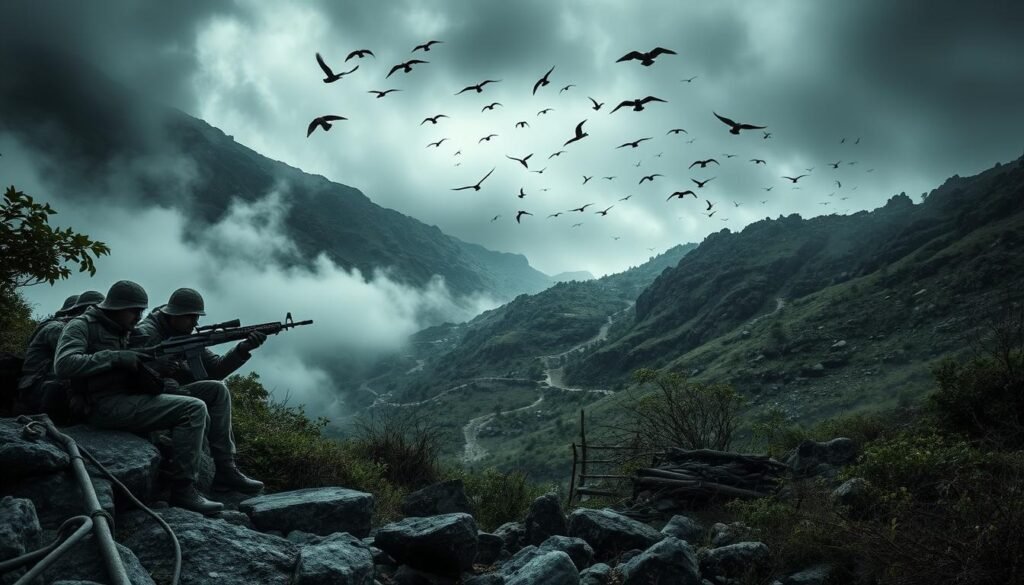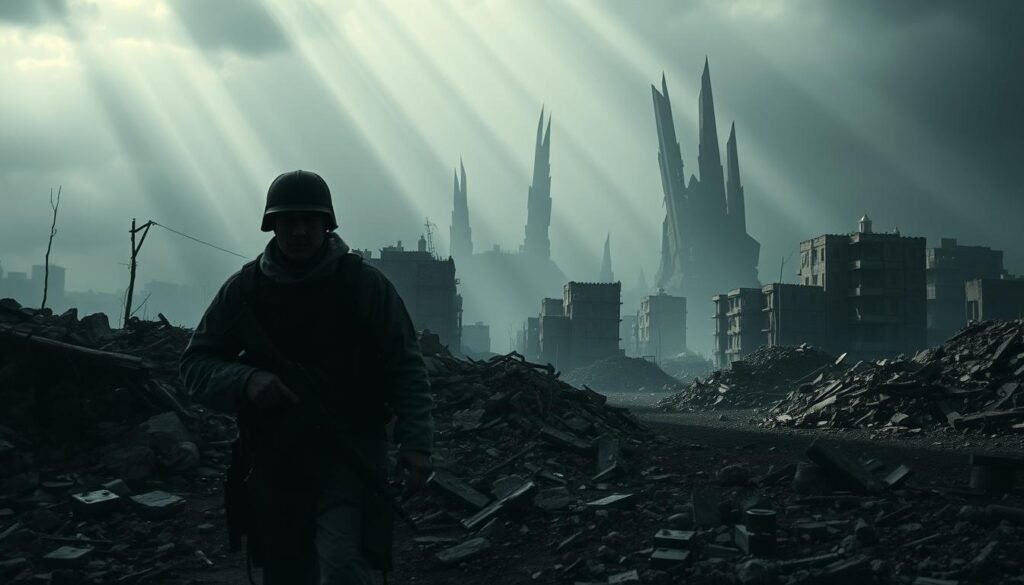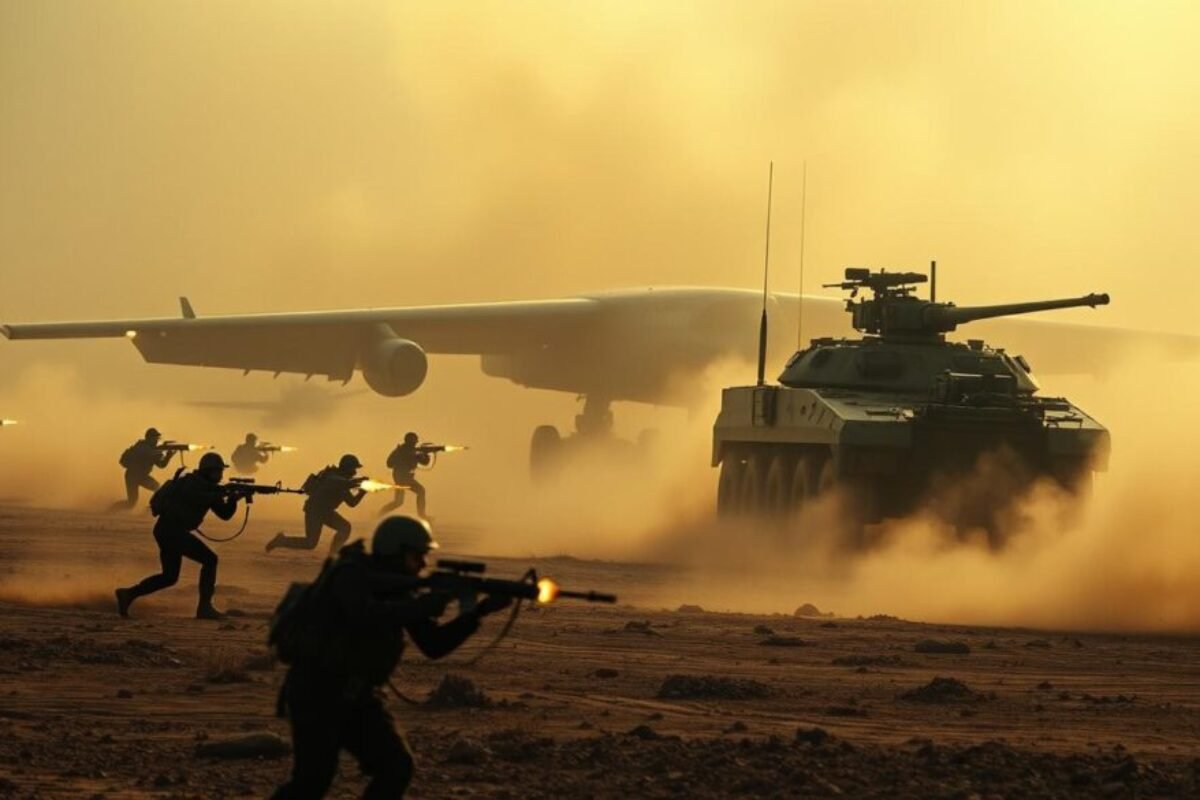The Rise of Asymmetric Warfare: How Small Powers Are Outsmarting Superpowers
In today’s world, military strength is often seen as the key to victory. But, surprisingly, only 10% of wars are won by the stronger side. This shows a big change in how wars are fought – a move towards asymmetric warfare.
In this new world, the underdog can win against the giant. They use smart, unconventional tactics. This makes the stronger side weak. Small groups, like nations or insurgent groups, are using these tactics against big powers.
These strategies are now key in fighting against insurgencies. Asymmetric warfare has become more important after the Cold War and the 9/11 attacks. It’s a complex and fascinating field.
Key Takeaways
- Asymmetric warfare means weaker powers can win through smart tactics.
- War tactics in asymmetric warfare are very different from old ways, leading to unexpected results.
- The rise of asymmetric warfare shows the need for flexibility and new ideas in military actions.
- Recent history shows more asymmetric warfare, where there’s a big power gap.
- Understanding asymmetric warfare is key to winning against insurgencies today.
The Evolution of Warfare: From Conventional to Asymmetric Strategies
Warfare has changed a lot over time. The military revolution brought new tactics with gunpowder. Now, we see a big move towards asymmetric warfare. This involves non-state actors and mixes hybrid warfare techniques.
Today, traditional battles are less common. Instead, we see more complex conflicts. Even though big powers have strong armies, smaller groups use smart tactics to fight back.
Asymmetric strategies use surprise and psychological attacks. Weaker groups avoid direct fights. They use the environment to their advantage, making their impact bigger without matching the enemy’s strength.
Hybrid warfare is a new tactic. It combines traditional military actions with cyber attacks and propaganda. This makes it hard for old military strategies to work.
Now, the line between war and peace is getting blurry. We face ongoing, low-level conflicts. This change makes us rethink how we approach security and defense.
Defining Asymmetric Warfare

Asymmetric warfare happens when there’s a big difference in military power between the sides. The weaker side uses ‘irregular warfare’ and ‘unconventional warfare methods’ to fight back. They aim to find the strong side’s weak spots through ‘asymmetric engagement’.
It’s about how groups with less power use their weaknesses as strengths. They use tactics not seen in regular battles. This way, they can surprise and outsmart stronger, tech-savvy militaries.
Asymmetric warfare starts when two sides are not evenly matched in military strength. The weaker side might use guerrilla tactics, terrorism, or cyber attacks. These methods target the strong side’s weak points, not their strong ones.
This kind of fight can last a long time. It makes the stronger side struggle to find new ways to win. The weaker side hopes to wear down the stronger side’s will to fight, both in battle and in public opinion.
We’ll look closer at how asymmetric warfare works in history and today. We’ll explore what drives these conflict styles and how they change traditional war ideas.
Historical Context and the Roots of Asymmetric Combat
The term asymmetric conflict may seem modern, but its roots go back a long way. Early battles showed that smaller, agile forces can beat bigger armies. This has shaped our view of military tactics and strategies.
These battles tell us that size doesn’t always mean victory. It’s a key lesson in warfare.
Examples from Ancient to Modern Conflicts
Asymmetric conflict has played a big role in warfare, from ancient times to today. The idea of using unusual strategies to outsmart stronger foes has always been key. Smaller forces can move fast and strike when least expected, making their weaknesses into strengths.
The Scythians Against Darius I: An Early Instance
The Scythians and Darius I had a famous battle that showed the power of asymmetric warfare. The Scythians knew the land well and moved fast, using hit-and-run tactics against the Persians. This made Darius I’s plans fail and showed the value of smart, flexible tactics against bigger armies.
| Conflict | Aggressor | Defender | Outcome |
|---|---|---|---|
| Scythians vs Darius I | Persia | Scythians | Scythians effectively avoid conquest through mobility |
This table shows how the underdog can win big by using smart strategies and understanding asymmetric conflict. It sets a model for future battles in history.
Guerrilla Warfare: The Quintessential Asymmetric Strategy

Guerrilla warfare is at the heart of asymmetric strategies. It flips traditional military thinking upside down. Small, lightly armed groups can take on big, well-equipped armies. They use flexibility and surprise to attack, making long, indecisive wars common.
Guerrilla tactics differ greatly from traditional military battles. Instead of direct fights, they use hit-and-run attacks and sabotage. They also hide in the environment, unlike big armies that fight openly.
Guerrilla warfare has had a big impact on global powers. In places like Vietnam and Afghanistan, big armies have struggled. Their usual strength, like numbers and tech, doesn’t matter against quick and smart guerrilla fighters.
| Aspect | Guerrilla Warfare | Traditional Warfare |
|---|---|---|
| Objective | Erosion of enemy’s will via hit-and-run tactics | Decisive victory through force and occupation |
| Engagement Style | Ambushes, sabotage | Open battles, front-line engagements |
| Logistics | Minimal, use of local resources | Heavy, reliant on supply chains |
| Impact on Superpowers | Drawn-out conflicts, attritional challenges | Clear, measurable outcomes based on territory and casualties |
Guerrilla tactics let small groups fight back against stronger foes. This shows how effective asymmetric strategies can be in today’s wars. It also changes how big powers see and fight in conflicts where these tactics are used.
Asymmetric Warfare in the 21st Century
The world of war has changed a lot in the 21st century. 21st-century warfare now uses modern military tactics and technology in warfare. This has changed how we think about strength and fighting.
Smaller states and groups without a state can now fight big powers. This is thanks to asymmetric conflict. It makes the playing field more even.
Looking at case studies and examples of asymmetric conflict, we see big changes. New tech like drones, cyber attacks, and spy systems has changed war. These tools help smaller groups fight against bigger ones.
- Case Studies: Looking at recent wars shows how asymmetry works. For example, drone use in the Middle East by non-state actors against state militaries.
- Technology in Warfare: Cyber attacks show how tech is key in war. They can disrupt systems without direct fighting.
This means we need to rethink old military plans. The future of war is all about adapting to new tech and tactics. It’s about staying ahead and changing the way we defend ourselves worldwide.
Asymmetric Warfare’s Psychological and Societal Impacts

Asymmetric warfare changes how nations think and live. It uses irregular warfare and counterinsurgency to affect people’s minds and will. We see how small groups use guerrilla tactics and propaganda to influence many, causing big psychological impact and societal effects.
| Aspect of Impact | Psychological Efffects | Societal Consequences |
|---|---|---|
| Community Cohesion | Increased anxiety and fear | Disruption of social structures |
| Public Morale | Decrease in trust towards government | Social divisions and increased polarisation |
| Economic Stability | Uncertainty and decline in investments | Higher unemployment rates, economic decline |
Asymmetric warfare is a big challenge, not just on the battlefield. It affects communities and society deeply. People and defenses face uncertainty and irregularity. This has long-lasting effects on many areas of life, showing the need for strong countermeasures and resilient societies.
Key Factors Behind the Success of Asymmetric Tactics
Asymmetric tactics are key in today’s conflicts. They use terrain advantages and local knowledge to counter stronger military forces. These tactics are vital for winning, so it’s important to know what they’re based on.
Importance of Terrain and Local Knowledge
Using terrain is key in asymmetric warfare. Small forces hide in forests, mountains, and cities to block big armies. This not only keeps them safe but also messes up the enemy’s plans.
Knowing the area well is also a big plus. Groups that understand the local terrain can set up ambushes and avoid big fights. This makes them hard to beat.
Utilizing Civilian Populations in Conflict
Civilians play a big role in asymmetric warfare. They can give important info and help small forces. But, using civilians can raise big ethical questions.
It can make fighting harder for big armies. This helps small forces win in long battles.
It’s important to understand these tactics. They show how asymmetric tactics use land and people to fight against stronger forces.
Military Innovation and Adaptive Strategies

In today’s world of war, we must always adapt and innovate. This is key to fighting against non-traditional enemies. We need strong strategies and new ideas to face these threats.
It’s vital for big powers to defend against new tactics. This leads to big changes in how we fight. It makes us think differently and push the limits of what’s possible.
Enemies use tactics that are hard to fight with old ways. So, we must be ready to change our plans. This helps us make smart choices in battles and shape our defense plans for the future.
Examples of Innovations in Asymmetric Warfare
Our military has seen many new tactics from enemies. They use technology like IEDs and cyber-attacks. This forces us to change how we fight.
How Superpowers Respond to Unconventional Threats
- We gather more intelligence to find and stop threats early.
- We create special programs to fight against insurgent groups.
- We work closer with local people to keep them safe and get important info.
These steps show how important it is to stay ahead. They help keep us safe in a world full of surprises.
We keep finding new ways to adapt and innovate. By using new tech and learning new tactics, we can fight off threats better. This helps us keep the peace more effectively.
| Innovation | Response Strategy |
|---|---|
| Cyber Intelligence | Enhanced Cyber Defense Units |
| Drone Surveillance | Anti-Drone Technology and Tactics |
| Information Warfare | Improved Information Security Protocols |
Case Study: Vietnam War
The Vietnam War case study gives us deep insights into modern combat. It shows how guerrilla tactics are key. We see how the North Vietnamese used these tactics and how they affected the American military.
Role of Guerrilla Tactics Against American Forces
The North Vietnamese and Viet Cong used guerrilla tactics well. They knew the terrain, with its jungles and tunnels, very well. This helped them launch surprise attacks and withdraw quickly.
These tactics made the fight even against the more advanced American military. They also made the war last longer and put a strain on American resources and morale.
Lessons Learned and Military Adaptations
The Vietnam War taught the US military important lessons. One key lesson was the need for better training in counterinsurgency. This training helped American forces prepare for future wars.
| Aspect | Tactical Response | Adaptation |
|---|---|---|
| Guerrilla Warfare | Limited engagement tactics | Development of counterinsurgency strategies |
| Use of Terrain | Technological surveillance | Enhanced jungle warfare training |
| Psychological Warfare | Morale-boosting initiatives | Improved soldier preparedness and resilience programs |
These changes show how the US military learned from Vietnam. They started to focus more on fighting guerrilla wars. This shift was a big part of their new strategies.
Case Study: The Use of Proxy Wars
In the world of international relations, proxy wars are a strategic way to fight without being directly involved. State actors use third-party groups to push their national interests. This method, known as asymmetric engagement, often hides the state’s role through covert operations.
Proxy wars help nations achieve big goals without the risks of direct war. They can avoid the backlash from other countries. By looking into these conflicts, we see the hidden forces that shape global policies.
| Feature | Benefit | Risk |
|---|---|---|
| Deniability | Preserves image on the global stage | Complicated international relationships if exposed |
| Cost-effective | Less resource expenditure than direct conflict | Potential for uncontrollable escalation |
| Local Proxy Support | Local forces have better knowledge and influence | Varied loyalty and unpredictable outcomes |
Proxy wars are a common choice for nations wanting to grow their influence without the costs of war. Exploring this complex area helps us understand its benefits and risks. This knowledge is key for making smart decisions in the future.
The Role of Non-State Actors in Asymmetric Conflicts
In today’s world, non-state actors play a big role in conflicts. Groups like insurgent and terrorist organizations use new ways to challenge governments. Their quick and unpredictable moves make old defense plans less useful.
Terrorist Organizations and Insurgent Groups
Insurgent and terrorist groups are big threats. They don’t follow the usual rules of war. They often target civilians to cause chaos. Knowing why they do this is key to stopping them.
Challenges in Countering Non-State Threats
Countering these groups is hard because they hide among civilians. Their loose structures make it hard to tell who’s fighting. To win, we need more than just military action. We must also help communities and challenge their ideas.
- Address socio-political drivers of extremism
- Deploy precise intelligence for targeted operations
- Minimize civilian casualties to avoid local grievances
Legal and Ethical Considerations in Asymmetric Warfare
In today’s conflicts, the legal and ethical questions of asymmetric warfare are key. We must carefully examine war ethics and international law. The treatment of combatants in these conflicts is a big challenge.
Traditional rules and laws, like those from international law, are being tested. Modern warfare tactics are changing fast.
International Laws and the Treatment of Combatants
International law is vital for protecting human rights in conflicts. The Geneva Conventions set standards for treating combatants. These laws aim to keep the rights and dignity of all combatants respected.
But, modern conflict often makes it hard to follow these rules. The unconventional nature of today’s warfare challenges these norms.
The Moral Dilemmas of Modern Warfare Tactics
Modern warfare tactics, like drone strikes and cyber warfare, bring up big moral questions. These tactics are effective but raise ethical concerns. They often affect civilians and how we target combatants.
As these tactics become more common, we need to rethink our ethics and laws. This is important for adapting to the changing nature of warfare.
Dealing with these issues requires a careful balance. We must consider both the harsh realities of combat and the need for ethical conduct and legal compliance. The conversation about the ethics and laws of modern conflict is both important and complex.
| Aspect | Challenges | Considerations |
|---|---|---|
| Combatant Rights | Protection in non-traditional environments | Upholding Geneva Conventions |
| Civilian Safety | Avoidance of collateral damage | Strict engagement rules |
| Technological Warfare | Ethical use of drones and cyber tools | Regulation and oversight |
In our exploration of asymmetric warfare, upholding war ethics is more important than ever. We must continue to engage with these issues. Our goal is to ensure warfare is conducted in line with our highest moral and legal standards.
The Future of Asymmetric Warfare
The world of asymmetric warfare evolution is changing fast. Cyber warfare and artificial intelligence are making big changes. They help smaller forces fight back against bigger ones, changing how we see future conflicts.
Looking into the future of war, we see big changes coming. Artificial intelligence and cyber warfare are changing how we fight. They let us disrupt and outsmart our enemies in the digital world.
Predicting the Next Evolution of Conflict
We need to think ahead to understand war’s future. Cyber warfare can now shut down a country’s systems without touching its land. This changes how we fight, making war a global issue that touches every part of society.
The Role of Cyber Warfare and Artificial Intelligence
Artificial intelligence is changing how we defend ourselves. It helps us spot and fight threats faster. Cyber warfare lets us attack our enemies’ systems, showing how digital and physical worlds meet in war.
In short, artificial intelligence, cyber warfare, and asymmetric warfare evolution are changing the battlefield. With these technologies, smaller forces can fight back against bigger ones. This is creating new ways of fighting in future conflicts.
Asymmetric Warfare
In today’s world, asymmetric threats are a big challenge for national security and global defense. To be ready for these unusual tactics, we need strong policy changes and smart strategies. Countries all over are updating their military plans to fight these irregular challenges well.
Exploring the details of these battles shows how important it is to understand and lessen the risks of asymmetric warfare. This kind of fight often uses strategies that big powers might miss. It needs a flexible and quick defense policy approach.
Global Stratagem and Defense Policies
Dealing with asymmetric threats means looking at global defense plans in a big way. This includes improving spy work and using new tech. It also means working together with other countries to fight these unpredictable threats better.
Adapting to Asymmetric Threats in National Security
Changing national security plans is vital for fighting asymmetric warfare. Our strategy includes many layers of defense, better teamwork between agencies, and new tech. Being ready for the unexpected helps a country stay strong against these threats.
Conclusion
Asymmetric warfare changes how we fight, making traditional ways outdated. Smaller powers use new tactics to challenge big powers. This forces big powers to rethink their plans.
History shows us how underdogs can win with smart strategies. The Vietnam War and guerrilla warfare are great examples. They used local knowledge and new tactics to succeed.
Adapting to these new threats is key for any military. We must stay strong and keep learning to face today’s complex threats. Our strategies need to be as flexible and informed as our enemies.
Cyber warfare and proxy wars are just a few examples. Our military skills and strategies must keep up with the changing nature of war.
Warfare is always changing, and we must be ready. Understanding these changes helps us prepare for the future. We need to be clever and strategic to face tomorrow’s challenges.





